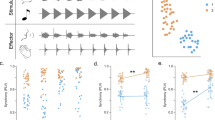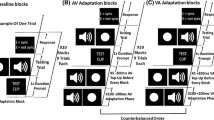Abstract
Humans display a natural tendency to move to the beat of music, more than to the rhythm of any other auditory stimulus. We typically move with music, but rarely with speech. This proclivity is apparent early during development and can be further developed over the years via joint dancing, singing, or instrument playing. Synchronization of movement to the beat can thus improve with age, but also with musical experience. In a previous study, we found that music perturbed synchronization with a metronome more than speech fragments; music superiority disappeared when distractors shared isochrony and the same meter (Dalla Bella et al., PLoS One 8(8):e71945, 2013). Here, we examined if the interfering effect of music and speech distractors in a synchronization task is influenced by musical training. Musicians and non-musicians synchronized by producing finger force pulses to the sounds of a metronome while music and speech distractors were presented at one of various phase relationships with respect to the target. Distractors were familiar musical excerpts and fragments of children poetry comparable in terms of beat/stress isochrony. Music perturbed synchronization with the metronome more than speech did in both groups. However, the difference in synchronization error between music and speech distractors was smaller for musicians than for non-musicians, especially when the peak force of movement is reached. These findings point to a link between musical training and timing of sensorimotor synchronization when reacting to music and speech distractors.





Similar content being viewed by others
Notes
Both the speech and music materials were highly controlled for familiarity. This was assessed for both the musical excerpts and speech fragments in a pilot experiment (see Dalla Bella et al. 2013). Thirty-two participants (13 musicians and 19 non-musicians; 28 females, mean age = 20.6 years, range 20–28 years) rated the distractors on a 10-point scale (1 = not familiar; 10 = very familiar). Note that the 13 musicians who participated in the pilot experiment also took part in the main experiment. Music and speech distractors did not differ in terms of familiarity (for music, mean rating = 6.7; for speech, mean rating = 7.0; t < 1). Moreover, ratings from musicians and non-musicians for music familiarity did not differ (for musicians, mean rating = 7.2; for non-musicians, mean rating = 6.4; t < 1).
1.5 Newton correspond to 300 μV, which is the force intensity typically needed to obtain a response using the computer keyboard or a response pad. One Newton is equivalent to the force needed to give a mass of 1 kg an acceleration of 1 m/s2.
References
Abercrombie D (1967) Elements of general phonetics. Aldine, Chicago
Arvaniti E (2009) Rhythm, timing and the timing of rhythm. Phonetica 66:46–63
Besson M, Chobert J, Marie C (2011) Transfer of training between music and speech: common processing, attention, and memory. Front Psychol 2:94
Białuńska A, Dalla Bella S, Jaśkowski P (2011) Increasing stimulus intensity does not affect sensorimotor synchronization. Psychol Res 75(1):43–53
Bigand E (1997) Perceiving musical stability: the effect of tonal structure, rhythm, and musical expertise. J Exp Psychol Hum Percept Perform 23:808–822
Bigand E (2003) More about the musical expertise of musically untrained listeners. Ann N Y Acad Sci 999:304–312
Bigand E, Parncutt R (1999) Perceiving musical tension in long chord sequences. Psychol Res 62:237–254
Bolger D, Coull JT, Schön D (2014) Metrical rhythm implicitly orients attention in time as indexed by improved target detection and left inferior parietal activation. J Cognitive Neurosci 26(3):593–605
Brzechwa J (1980) Brzechwa dzieciom. Warszawa, Nasza Księgarnia
Colonius H, Diederich A (2010) The optimal time window of visual-auditory integration: a reaction time analysis. Front Integr Neurosci 4:11–12
Cummins F (2009) Rhythm as an affordance for the entrainment of movement. Phonetica 66:15–28
Dalla Bella S, Białuńska A, Sowiński J (2013) Why movement is captured by music, but less by speech: role of temporal regularity. PLoS One 8(8):e71945
Dauer RM (1983) Stress-timing and syllable-timing reanalyzed. J Phon 11:51–62
Donnet S, Bartolo R, Fernandes JM, Cunha JP, Prado L, Merchant H (2014) Monkeys time their pauses of movement and not their movement-kinematics during a synchronization-continuation rhythmic task. J Neurophysiol 111:2138–2149
Drake C, Bertrand D (2001) The quest for universals in temporal processes in music. Ann N Y Acad Sci 930:17–27
Drake C, Jones MR, Baruch C (2000) The development of rhythmic attending in auditory sequences: attunement, reference period, focal attending. Cognition 77:251–288
Faul F, Erdfelder E, Lang A-G, Buchner A (2007) G*Power 3: a flexible statistical power analysis program for the social, behavioral, and biomedical sciences. Behav Res 39:175–191
Flaugnacco E, Lopez L, Terribili C, Montico M, Zoia S, Schön D (2015) Music training increases phonological awareness and reading skills in developmental dyslexia: a randomized control trial. PLoS One 10(9):e0138715
Fujioka T, Trainor LJ, Large EW, Ross B (2012) Internalized timing of isochronous sounds is represented in neuromagnetic beta oscillations. J Neurosci 32:1791–1802
Hallam S, Creech A, Varvarigou M, McQueen H, Gaunt H (2014) Does active engagement in community music promote enhanced quality of life in older people? Art Health 6(2):101–116
Hove MJ, Fairhurst MT, Kotz SA, Keller PE (2013) Synchronizing with auditory and visual rhythms: an fMRI assessment of modality differences and modality appropriateness. Neuroimage 67:313–321
Jaśkowski P, Włodarczyk D (2006) Task modulation of the effect of brightness on reaction time and response force. Int J Psychophysiol 61:98–112
Jones MR (2009) Musical time. In: Hallam S, Cross I, Thaut M (eds) The Oxford handbook of music psychology. Oxford University, Oxford, pp 81–92
Jones MR (2010) Attending to sound patterns and the role of entrainment. In: Nobre C, Coull JT (eds) Attention and time. Oxford University, New York, pp 317–330
Jones MR, Pfordresher PQ (1997) Tracking melodic events using joint accent structure. Can J Exp Psychol 51:271–291
Keller PE (2008) Joint action in music performance. In: Morganti F, Carassa A, Riva G (eds) Enacting intersubjectivity: a cognitive and social perspective to the study of interactions. IOS Press, Amsterdam, pp 205–221
Keller PE, Novembre G, Hove MJ (2014) Rhythm in joint action: psychological and neurophysiological mechanisms for real-time interpersonal coordination. Philos T R Soc B 369:20130394
Kraus N, Chandrasekaran B (2010) Music training for the development of auditory skills. Nat Rev Neurosci 11:599–605
Large EW, Jones MR (1999) The dynamics of attending: how people track time-varying events. Psychol Rev 106(1):119–159
Large EW, Palmer C (2002) Perceiving temporal regularity in music. Cogn Sci 26:1–37
Lehiste I (1977) Isochrony reconsidered. J Phon 5:253–263
Liberman M, Prince A (1977) On stress and linguistic rhythm. Linguist Inq 8:249–336
Lidji P, Palmer C, Peretz I, Morningstar M (2011) Listeners feel the beat: entrainment to English and French speech rhythms. Psychon Bull Rev 18:1035–1041
London J (2012) Hearing in time. Psychological aspects of musical meter. New York, Oxford University
Mégevand P, Molholm S, Nayak A, Foxe JJ (2013) Recalibration of the multisensory temporal window of integration results from changing task demands. PLoS One 8(8):e71608
Nozaradan S, Zerouali Y, Peretz I, Mouraux A (2013) Capturing with EEG the neural entrainment and coupling underlying sensorimotor synchronization to the beat. Cereb Cortex 25(3):736–747
Occelli V, Spence C, Zampini M (2011) Audiotactile interactions in temporal perception. Psychon Bull Rev 18:429–454
Patel AD (2008) Music, language, and the brain. Oxford University, New York
Patel AD (2011) Why would Musical Training Benefit the Neural Encoding of Speech? The OPERA Hypothesis. Front Psychol 2(142):142
Patel AD, Daniele JR (2003) An empirical comparison of rhythm in language and music. Cognition 87:B35–B45
Pike KN (1945) The intonation of American English. University of Michigan, Ann Arbor
Repp BH (1998) A microcosm of musical expression. I. Quantitative analysis of pianists’ timing in the initial measures of Chopin’s Etude in E major. J Acoust Soc Am 104:1085–1100
Repp BH (2000) Compensation for subliminal timing perturbations in perceptual-motor synchronization. Psychol Res 63:106–128
Repp BH (2001) Phase correction, phase resetting, and phase shifts after subliminal timing perturbations in sensorimotor synchronization. J Exp Psych Hum Percept Perform 27:600–621
Repp BH (2002) Automaticity and voluntary control of phase correction following event onset shifts in sensorimotor synchronization. J Exp Psych Hum Percept Perform 28:410–430
Repp BH (2003) Phase attraction in sensorimotor synchronization with auditory sequences: effects of single and periodic distractors on synchronization accuracy. J Exp Psychol Hum Percept Perform 29:290–309
Repp BH (2004) On the nature of phase attraction in sensorimotor synchronization with interleaved auditory sequences. Hum Mov Sci 23:389–413
Repp BH (2005) Sensorimotor synchronization: a review of the tapping literature. Psychon Bull Rev 12(6):969–992
Repp BH (2006) Rate limits of sensorimotor synchronization. Adv Cog Psych 2:163–181
Repp BH (2010) Sensorimotor synchronization and perception of timing: effect of music training and task experience. Hum Mov Sci 29:200–213
Repp BH, Doggett R (2007) Tapping to a very slow beat: a comparison of musicians and non-musicians. Music Percept 24:367–376
Repp BH, Keller PE (2004) Adaptation to tempo changes in sensorimotor synchronization: effects of intention, attention, and awareness. Q J Exp Psychol 57A:499–521
Repp BH, Penel A (2004) Rhythmic movement is attracted more strongly to auditory than to visual rhythms. Psychol Res 68:252–270
Repp BH, Su Y-H (2013) Sensorimotor synchronization: a review of recent research (2006–2012). Psychon Bull Rev 20:403–452
Roy C, Dalla Bella S, Lagarde J (2016) To bridge or not to bridge the multisensory time gap: bimanual coordination to sound and touch with temporal lags. Exp Brain Res. doi:10.1007/s00221-016-4776-4
Selkirk EO (1984) Phonology and syntax: the relation between sound and structure. MIT Press, Cambridge, MA
Slater J, Kraus N (2015) The role of rhythm in perceiving speech in noise: a comparison -of percussionists, vocalists and non-musicians. Cogn Process. doi:10.1007/s10339-015-0740-7
Stevens C, Byron T (2009) Universals in musical processing. In: Hallam S, Cross I, Thaut M (eds) Oxford handbook of music psychology. Oxford University, New York, pp 14–123
Thaut MH, Miller RA, Schauer LM (1998) Multiple synchronization strategies in rhythmic sensorimotor tasks: phase vs. period correction. Biol Cybern 79:241–250
Thompson EC, White-Schwoch T, Tierney A, Kraus N (2015) Beat synchronization across the lifespan: intersection of development and musical experience. PLoS One 10(6):e0128839
Tierney A, Kraus N (2014) The ability to move to a beat is linked to the consistency of neural responses to sound. J Neurosci 33(38):14981–14988
Tillmann B, Bigand E (2001) Global context effect in normal and scrambled musical sequences. J Exp Psychol Hum Percept Perform 27(5):1185–1196
Trainor LJ, Shahin AJ, Roberts LE (2009) Understanding the benefits of musical training: effects on oscillatory brain activity. Ann NY Acad Sci 1169:133–142
Tuwim J (1980) Wiersze dla dzieci. Warszawa, Nasza Księgarnia
Villing RC, Repp BH, Ward TE, Timoney JM (2011) Measuring perceptual centers using the phase correction response. Atten Percept Psychophys 73:1614–1629
Woodruff Carr K, White-Schwoch T, Tierney AT, Straita DL, Kraus N (2014) Beat synchronization predicts neural speech encoding and reading readiness in preschoolers. PNAS 111(40):14559–14564
Zatorre RJ, Chen JL, Penhune VB (2007) When the brain plays music: auditory–motor interactions in music perception and production. Nat Rev Neurosci 8:547–558
Acknowledgements
We thank the Editor and two anonymous Reviewers for their helpful comments on the manuscript. The study was supported by a Junior grant from the Institute Universitaire de France to SDB, and a Marie Curie ITN grant from the European Union (7th Framework Programme) to AB.
Author information
Authors and Affiliations
Corresponding authors
Rights and permissions
About this article
Cite this article
Białuńska, A., Dalla Bella, S. Music and speech distractors disrupt sensorimotor synchronization: effects of musical training. Exp Brain Res 235, 3619–3630 (2017). https://doi.org/10.1007/s00221-017-5080-7
Received:
Accepted:
Published:
Issue Date:
DOI: https://doi.org/10.1007/s00221-017-5080-7




